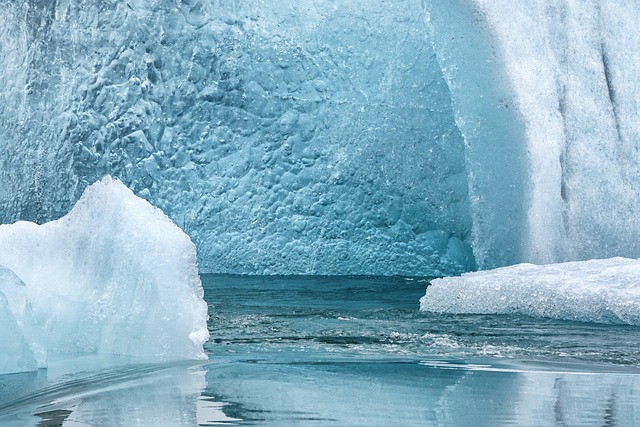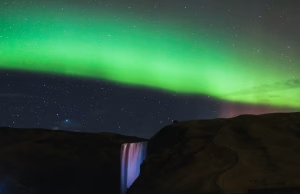As the short days of winter stretch out their frosty fingers over the North Atlantic, Iceland in February becomes a land of ice and fire, where steaming hot springs meet frozen waterfalls and the night sky dances with the ethereal glow of the aurora borealis.
While February may be one of the coldest months to visit this island nation, it’s also a time when Iceland’s rugged beauty shines through in unexpected ways. In this comprehensive guide, we’ll discuss:
- Is February a Good Time to Visit Iceland?
- Iceland’s Weather in February
- Cultural Experiences
- Events & Festivals
- Top Things To Do in Iceland in February
- Famous Places to Eat in Iceland in February
- Where to Stay in Iceland?
- Average Cost of a Trip to Iceland
- Tips for Making the Most of Your Iceland Adventure
- Why Choose OneVasco?
- FAQs
Is February a Good Time to Visit Iceland?
For adventurous travelers who don’t mind bundling up, February can be an excellent time to explore Iceland’s winter wonderland. Here are a few reasons why:
- Northern Lights: The long, dark nights of February provide the perfect backdrop for viewing the mesmerizing northern lights. With up to 18 hours of darkness per day, your chances of spotting this celestial spectacle are high.
- Winter Activities: From snowmobiling across glaciers to hiking through ice caves, February offers thrilling winter activities showcasing Iceland’s unique landscape.
- Fewer Crowds: As one of the quieter months for tourism, February allows you to experience Iceland’s top attractions with fewer crowds and lower prices compared to the busy summer season.
Iceland’s Weather in February
When planning a trip to Iceland in February, it’s crucial to be prepared for the weather conditions. The average temperature ranges from -1°C to 4°C (30°F to 39°F), with occasional dips to -5°C (23°F). The wind chill can make the temperatures feel even colder, so packing warm layers is essential.
February is also known for its unpredictable weather, with a mix of snow, rain, and sleet. On average, the country receives about 80 mm of precipitation during this month. While the weather can change rapidly, it adds to the adventurous spirit of exploring Iceland in the heart of winter.
| Weather Conditions | February in Iceland |
|---|---|
| Average Temperature | -1°C to 4°C (30°F to 39°F) |
| Precipitation | 80 mm |
| Daylight Hours | 7-10 hours |
| Wind Speed | 10-15 m/s |
Cultural Experiences
While February may not have the major festivals of other months, there are still plenty of opportunities to immerse yourself in Icelandic culture:
- Þorrablót: This mid-winter feast, held throughout February, celebrates traditional Icelandic cuisine and Viking culture. Expect to sample fermented shark, sour ram’s testicles, and other adventurous dishes.
- Pool Culture: Icelanders love their geothermal pools, and February is the perfect time to join them. Warm up in the steamy waters of local favorites like Laugardalslaug in Reykjavik or Lýsuhólslaug on the Snæfellsnes Peninsula.
- Icelandic Sagas: Delve into Iceland’s rich literary heritage by visiting sites associated with the famous Icelandic Sagas, such as Reykholt, home of the 13th-century scholar Snorri Sturluson.

Events & Festivals
While February may be quieter than other months, there are still a few notable events:
1. Winter Lights Festival
- When: It’s usually held annually on the first weekend of February.
- Where: Reykjavik and surrounding municipalities
- Major Highlights:
- Light Trail: A walking path featuring stunning light installations from 6:30 PM to 10:30 PM daily.
- Museum Night: On February 2, museums open from 6:00 PM to 11:00 PM, offering unique events like dance, theater, and live music.
- Pool Night: On February 1, visitors can enjoy free access to various thermal pools from 5:00 PM to 10:00 PM, with special activities and illuminations.
2. Reykjavik International Games
- When: Early February (exact dates vary annually)
- Where: Various venues in Reykjavik
- Major Highlights:
- A multi-sport event featuring competitions in disciplines such as figure skating and martial arts, attracting athletes from around the world.
3. Stockfish Film Festival
- When: Early February (exact dates vary annually)
- Where: Multiple venues across Reykjavik
- Major Highlights:
- Showcases independent cinema from around the globe with screenings and events designed to promote film culture.
Top Things To Do in Iceland in February
1. Chase the Northern Lights
February’s long, dark nights make it one of the best times of year to witness the aurora borealis. For the best chances of success, head away from the city lights and join a guided tour led by expert aurora hunters.
2. Explore an Ice Cave
Venture deep inside a glacier with a guided ice cave tour. February is prime time for these crystalline caverns, which are only accessible during the winter months. Don’t miss the stunning blue ice caves of Vatnajökull, Europe’s largest glacier.
3. Soak in a Hot Spring
There’s no better way to ward off the February chill than by slipping into a steamy geothermal pool. While the famous Blue Lagoon is always a good choice, consider seeking out lesser-known hot pots like Seljavallalaug, nestled in a valley near the south coast.
4. Go Snowmobiling
For an adrenaline-pumping way to explore Iceland’s winter landscape, hop on a snowmobile and zoom across a glacier or through powdery snowfields. Popular spots include the Langjökull glacier and the Mýrdalsjökull ice cap.
5. Visit a Frozen Waterfall
February is the perfect time to see Iceland’s waterfalls transformed into glittering ice sculptures. Don’t miss Gullfoss on the Golden Circle route, or Skógafoss and Seljalandsfoss along the south coast.

Famous Places to Eat in Iceland in February
While Iceland isn’t known for its culinary scene, there are still plenty of delicious dishes to try during your February visit:
- Icelandic Street Food: This cozy spot in downtown Reykjavik serves up traditional Icelandic dishes like lamb soup, fish stew, and pancakes with skyr.
- Messinn: For some of the freshest seafood in Reykjavik, head to Messinn, where the fish of the day is always a winner.
- Friðheimar: Located in the greenhouse-filled village of Reykholt, this unique restaurant serves tomato-based dishes grown on-site, including tomato soup, tomato beer, and tomato ice cream.
Where to Stay in Iceland?
When it comes to accommodations, Iceland offers a range of options to suit different budgets and preferences. Here are some popular choices for where to stay in Iceland in February:
- Reykjavik:
- As the capital city, Reykjavik has the widest selection of hotels, guesthouses, and hostels.
- Staying in the city center puts you within walking distance of many attractions, restaurants, and bars.
- Recommended hotels: Kvosin Downtown Hotel, Canopy by Hilton Reykjavik City Centre, Icelandair Hotel Reykjavik Marina.
- Akureyri:
- Known as the “Capital of the North,” Akureyri is a charming town with a variety of accommodations.
- It serves as a great base for exploring North Iceland and the Mývatn area.
- Recommended hotels: Icelandair Hotel Akureyri, Hotel Kea, Saeluhus Apartments & Houses.
- Vik:
- Located on the South Coast, Vik is a popular stopover for those exploring Iceland’s southern attractions.
- It offers stunning views of the nearby black sand beaches and sea stacks.
- Recommended hotels: Hotel Kria, Black Beach Suites.
- Hveragerði:
- This small town is known for its geothermal activity and is home to the Reykjadalur Hot Spring Trail.
- Staying here allows you to enjoy the thermal pools and explore the surrounding countryside.
- Recommended hotels: Frost and Fire Hotel, Hotel Örk.
- Countryside Farmstays and Cottages:
- For a more authentic and secluded experience, consider staying at a farm-stay or renting a cottage in the countryside.
- These accommodations often offer stunning views of the Icelandic landscape and a chance to see the Northern Lights away from city lights.
- Recommended farm-stays and cottages: Efstidalur II, Vogafjos Farm Resort, Heydalur Guesthouse.
When booking accommodations in February, keep in mind that some rural hotels and guesthouses may have limited availability due to the winter season. It’s always a good idea to book in advance to secure your preferred choice.

Average Cost of a Trip to Iceland
While Iceland is known for being an expensive destination, visiting in February can help you save on accommodations and activities compared to the busy summer months. Here’s a rough breakdown of what you can expect to spend:
| Expense | Average Cost (USD/INR) |
|---|---|
| Accommodation (per night) | $80-200 (INR 6,800-17,200) |
| Meals (per day) | $40-80 (INR 3,500-6,800) |
| Activities (per person) | $50-200 (INR 4,300-17,200) |
| Transportation (per day) | $50-100 (INR 4,300-8,600) |
Tips for Making the Most of Your Iceland Adventure
Local Etiquette
- Remove your shoes before entering someone’s home.
- Don’t tip at restaurants (service is included in the price).
- Be respectful of nature and stick to marked trails.
Safety and Health
- Check the weather and road conditions before heading out.
- Dress in warm, waterproof layers to avoid hypothermia.
- Carry a first-aid kit and know how to use it.
Transportation
- Rent a 4WD vehicle if you plan to drive outside of Reykjavik.
- Consider taking public buses or joining a guided tour if you’re not comfortable driving in winter conditions.
Currency
- Iceland uses the Icelandic króna (ISK).
- Credit cards are widely accepted, but it’s a good idea to carry some cash for smaller purchases.
Why Choose OneVasco?
OneVasco makes visa applications effortless. Our expert team manages the entire process, allowing you to focus on your journey.
Enjoy stress-free travel with fast visa approvals.
- Expert and Personalized Support
- Efficient and Hassle-Free Process
- Real-Time Tracking and Updates
- Transparent Communication
- Trusted by Millions
FAQs
1. What are the best things to do in Iceland in February?
Some of the top activities in Iceland in February include:
- Chasing the northern lights
- Exploring ice caves
- Soaking in hot springs
- Snowmobiling on glaciers
- Visiting frozen waterfalls
2. Is Iceland cold in February?
Yes, Iceland is quite cold in February, with average temperatures ranging from -3°C to 3°C (26-38°F). However, the wind chill can make it feel even colder, so it’s important to dress in warm, waterproof layers.
3. What can I wear in Iceland in February?
To stay warm and dry in Iceland in February, pack the following:
- Warm, waterproof jacket and pants
- Thermal base layers
- Wool socks
- Sturdy, waterproof boots
- Hat, gloves, and scarf
- Swimsuit and towel (for hot springs)
4. Is Iceland expensive to visit in February?
While Iceland is generally an expensive destination, visiting in February can be more affordable than during the peak summer months. Expect to spend around $80-200 per night on accommodation, $40-80 per day on meals, and $50-200 per person on activities.
5. How safe is Iceland?
Iceland is consistently ranked as one of the safest countries in the world. However, it’s still important to take precautions when traveling in winter, such as checking weather and road conditions before heading out and dressing appropriately for the cold.
6. What can I see in Iceland in February?
Some of the top sights to see in Iceland in February include:
- The northern lights
- Frozen waterfalls like Gullfoss, Skógafoss, and Seljalandsfoss
- Ice caves in Vatnajökull glacier
- Geothermal areas like the Geysir hot spring
- The rugged coastline of the Snæfellsnes Peninsula
7. Will it rain in Iceland in February?
While snow is more common than rain in Iceland in February, you can still expect some wet weather during your visit. Be sure to pack waterproof gear and check the forecast before heading out.
8. What are the major Events & Festivals in Iceland in February?
Some of the main events and festivals in Iceland in February include:
- Winter Lights Festival (early February)
- Reykjavik International Games (mid-February)
- Stockfish Film Festival (late February)
- Þorrablót (mid-winter feast held throughout February)





















